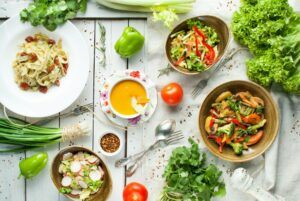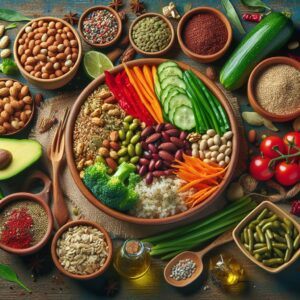
I’m going to introduce you to the whole food plant-based (WFPB) lifestyle, which might just change the way you look at your plate. A WFPB diet focuses on foods in their most natural state. This isn’t just about cutting out meat; it’s also about minimizing processed foods and prioritizing plants in their whole, unrefined form.
You’re going to find out about the health perks that come with this way of eating, such as a lower risk for chronic diseases like heart disease, diabetes, and certain cancers. I’ll also touch on how this diet can enhance your energy levels and potentially contribute to weight loss and improved digestion.
A lot is happening very quickly on our planet, and adopting a WFPB diet can positively impact the environment by reducing your carbon footprint, conserving water, and supporting a more sustainable food system.
Don’t worry too much about the misconceptions swarming around plant-based diets. I’m here to help you understand that you can indeed get enough protein, iron, and other essential nutrients from plants. Plus, you don’t have to sacrifice flavor for nutrition—WFPB diets can be incredibly delicious and varied.
Choose something that resonates with you, and remember, transitioning to a WFPB diet is a journey. You can always adjust your approach down the road. Now, having a well-stocked kitchen is key to making this lifestyle work for you, which is why I’m going to guide you through setting up your pantry with WFPB essentials next.
Stocking Your Kitchen for Success: WFPB Pantry Essentials

Let’s set the stage for your plant-powered kitchen. Finding success with a Whole Food Plant-Based diet is much easier when your pantry is properly outfitted. So, what do you need to keep on hand? Your pantry should be bursting with a variety of grains, legumes, seeds, nuts, and spices that form the backbone of WFPB recipes.
In my opinion, sticking to a budget while eating healthily is critical. Whole foods don’t have to break the bank. Bulk buying, focusing on seasonal produce, and opting for store brands can significantly slash your grocery bills. And remember, whole grains like brown rice and oats, dried beans, and lentils are not only affordable but also incredibly versatile.
Organizing your space can make plant-based cooking far more efficient. Clear containers with labels create an easy system to find what you need when you need it. Plus, you’re more likely to use items you can see and reach easily. This approach extends to your fridge and freezer, where fresh and frozen produce should be front and center, ready for action.
When it comes to fruits and vegetables, I’m all about embracing seasonality. Eating with the seasons means your food is fresher, tastier, and often, more nutritious. Plus, it’s a great way to support local farmers and reduce your carbon footprint. Consider a weekend farmers market adventure to explore what’s in season now.
Recipe Round-Up: Simple and Delicious WFPB Dishes

When you’re starting a whole food plant-based diet, figuring out what to eat can be the trickiest part. But don’t worry too much about that; I’ve got some seriously tasty and easy WFPB recipes for you. These are designed to be approachable, using common ingredients and simple cooking methods. Something to remember: your first attempt doesn’t need to be your last, so feel free to play around and adjust these recipes to your liking!
For breakfast, how about starting your day with a nutritious bang? You’re going to find out about morning staples like banana oat pancakes that are naturally sweetened and full of fiber. Or if you’re in a rush, a green smoothie packed with spinach, avocado, and a splash of lemon could be your go-to energizer.
“Banana Oat Pancake Extravaganza”
Ingredients:
– 1 cup oat flour
– 1/2 cup whole wheat flour
– 1/2 cup mashed ripe bananas
– 1/2 cup plant-based milk
– 1/4 cup pure maple syrup
– 1/4 cup chopped walnuts
– 1 tsp baking powder
– 1/2 tsp salt
– 1/2 tsp ground cinnamon
– 1/4 tsp ground nutmeg
– 1/4 tsp ground cardamom
– 1 tbsp chia seeds
– 1 tbsp hemp seeds
– 1 tbsp coconut flakes (optional)Instructions:
1. In a large bowl, combine oat flour, whole wheat flour, baking powder, salt, cinnamon, nutmeg, and cardamom.
2. In a separate bowl, mix together mashed bananas, plant-based milk, maple syrup, and chia seeds. Let it sit for 5 minutes to allow the chia seeds to gel.
3. Add the wet ingredients to the dry ingredients and stir until combined. Do not overmix.
4. Fold in chopped walnuts and hemp seeds.
5. Heat a non-stick pan or griddle over medium heat.
6. Drop 1/4 cupfuls of the batter onto the pan and cook for 2-3 minutes, until bubbles appear on the surface and the edges start to dry.
7. Flip and cook for an additional 1-2 minutes, until golden brown.
8. Serve warm with your favorite toppings, such as coconut flakes, fresh fruit, nut butter, or a drizzle of maple syrup.These pancakes are a game-changer! The combination of oat flour, whole wheat flour, and chia seeds provides a nutty and filling base, while the mashed bananas add natural sweetness. The walnuts and hemp seeds add a delightful crunch, and the coconut flakes provide a tropical touch. Enjoy!
Moving on to lunch, we’re talking about hearty salads that are anything but boring. Picture a kale and quinoa bowl drizzled with a tangy tahini dressing, or a vibrant beetroot and chickpea salad that’s as nourishing as it is colorful. Choose something that resonates with you, and lunch will be a meal to look forward to.
“Kale and Quinoa Bowl”
Ingredients:
– 1 cup quinoa, rinsed and drained
– 2 cups water or vegetable broth
– 2 cups curly kale, stems removed and discarded, leaves coarsely chopped
– 1/2 cup diced roasted sweet potato
– 1/2 cup diced red onion
– 1/4 cup chopped fresh parsley
– 1/4 cup chopped fresh mint leaves
– Salt and pepper to tasteInstructions:
1. Rinse the quinoa and cook according to package instructions.
2. Preheat the oven to 400°F (200°C).
3. Toss the sweet potato and red onion with a pinch of salt and pepper on a baking sheet. Roast for 20-25 minutes or until tender.
4. In a large bowl, massage the kale leaves with your hands for about 2-3 minutes to tenderize them.
5. Add the cooked quinoa, roasted sweet potato and red onion, parsley, and mint leaves to the bowl with the kale.
6. Toss to combine and season with salt and pepper to taste.Tangy Tahini Dressing:
Ingredients:
– 1/2 cup tahini
– 1/4 cup freshly squeezed lemon juice
– 1/4 cup water
– 1 tablespoon apple cider vinegar
– 1 teaspoon date syrup
– 1/2 teaspoon salt
– 1/4 teaspoon black pepperInstructions:
1. In a small bowl, whisk together the tahini, lemon juice, water, apple cider vinegar, date syrup, salt, and black pepper until smooth and creamy.
2. Taste and adjust the dressing as needed.Assembly:
1. Divide the kale and quinoa mixture into bowls.
2. Drizzle the tangy tahini dressing over the top.
3. Serve immediately and enjoy!This recipe combines the nutty flavor of quinoa with the earthy taste of kale, sweet and tender roasted sweet potato, and refreshing herbs. The tangy tahini dressing adds a creamy and zesty element that brings everything together. Enjoy!
As evening rolls around, dinner is where you can really get creative. I’m going to show you how to whip up a creamy coconut lentil curry that’ll have everyone asking for seconds. And let’s not forget about making a robust chili with beans and an assortment of veggies – perfect for those nights when you want something warming and filling.
“Creamy Coconut Lentil Curry”
Ingredients:
– 1 cup brown or green lentils, rinsed and drained
– 2 cups water or vegetable broth
– 1 medium onion, chopped
– 2 cloves garlic, minced
– 1 medium ginger, grated
– 1 tablespoon curry powder
– 1 teaspoon ground cumin
– 1/2 teaspoon turmeric
– 1/2 teaspoon cayenne pepper (optional)
– 1 can (14 oz) diced tomatoes
– 1 cup coconut milk
– 1/4 cup chopped fresh cilantro (optional)
– Salt and pepper to tasteInstructions:
1. In a large saucepan, sauté the onion, garlic, and ginger in a little water until softened.
2. Add the curry powder, cumin, turmeric, and cayenne pepper (if using) and cook for 1-2 minutes, stirring constantly.
3. Add the lentils, water or broth, and diced tomatoes. Bring to a boil, then reduce the heat and simmer for 20-25 minutes or until the lentils are tender.
4. Stir in the coconut milk and adjust the seasoning as needed.
5. Serve hot, garnished with chopped cilantro (if desired).This recipe combines the comforting warmth of lentils with the creamy richness of coconut milk and the vibrant flavors of Indian spices. Enjoy!
Variations:
– Add some heat with more cayenne pepper or red pepper flakes
– Mix in some frozen spinach or kale for an extra nutritional boost
– Substitute other vegetables like bell peppers or carrots for added flavor and texture
– Serve over rice, with naan bread, or as a soupTips:
– Use red or yellow lentils for a slightly different flavor and texture
– Add a squeeze of fresh lime juice for extra brightness
– Experiment with different spice blends or herbs for unique flavor profiles
And guess what? Plant-based eating doesn’t mean skipping dessert! On the sweeter side of things, we’re exploring desserts like avocado chocolate mousse and apple cinnamon crumble. They not only satisfy your sweet tooth but also contribute to your daily fruit intake.
“Avocado Chocolate Mousse”
Ingredients:
– 3 ripe avocados
– 1/2 cup unsweetened cocoa powder
– 1/4 cup maple syrup
– 1/4 cup coconut cream (chilled)
– 1/2 teaspoon vanilla extract
– Pinch of salt
– 1/4 cup melted coconut oil (optional)Instructions:
1. Peel and pit the avocados and place them in a blender or food processor.
2. Add the cocoa powder, maple syrup, coconut cream, vanilla extract, and salt. Blend until smooth and creamy.
3. Taste and adjust the sweetness or flavor as needed.
4. Spoon the mousse into individual serving cups or a large serving dish.
5. Chill in the refrigerator for at least 2 hours or until set.
6. If desired, drizzle with melted coconut oil for a decorative touch.This recipe combines the creaminess of avocados with the richness of cocoa powder and the sweetness of maple syrup, all while being free of dairy and refined sugars. Enjoy!
Variations:
– Add a pinch of cinnamon or nutmeg for extra spice
– Mix in some chopped nuts or shredded coconut for added texture
– Use different types of non-dairy milk or creamers for varying flavors
– Top with fresh fruit or whipped coconut cream for a decorative touchTips:
– Use ripe avocados for the best flavor and texture
– Adjust the amount of maple syrup to your taste
– Experiment with different types of cocoa powder or melted chocolate for unique flavor profiles
These recipes aren’t just about tantalizing your taste buds, they’re also about simplicity and nutrition. A lot is happening very quickly when you switch to a WFPB diet, and having a few standby recipes can make the transition smoother. Now, let’s talk about connecting with others on this journey…
Beyond the Plate: Building a Community Around WFPB Eating

Choosing a Whole Food Plant-Based diet is more than just about what you eat, it’s about joining a larger movement toward health and sustainability. I’m going to show you that this journey doesn’t have to be a solitary one.
WFPB diets and social interactions: tips for dining out and gatherings. If you want to maintain your dietary choices while enjoying social events, there are strategies to help you navigate restaurant menus and family dinners. Opt for vegetarian-friendly restaurants or suggest hosting a potluck where you can bring a WFPB dish.
How to introduce family and friends to WFPB meals: Don’t worry too much about a hard sell; instead, let the flavors do the talking. Share delicious meals with loved ones to pique their interest. Choose recipes that are familiar yet plant-based, reducing the intimidation factor.
Joining local and online plant-based communities can be a game-changer. In these spaces, you’ll find recipe swaps, potlucks, and plenty of support. These communities are a wonderful resource for anyone looking to expand their WFPB lifestyle.
And finally, let’s talk about the ripple effect of WFPB eating. Each person who adopts this lifestyle can impact countless others, from family and friends to local businesses and even global food systems. By sharing your journey and supporting plant-based options in markets and restaurants, you contribute to broader change.
